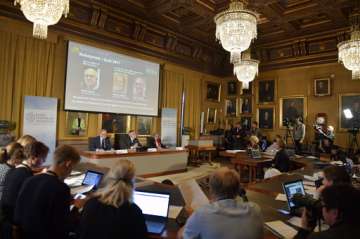The Nobel Physics Prize 2017 has been awarded to three scientists for their discoveries in gravitational waves.
Sweden's Royal Academy of Sciences announced Tuesday that the winners are Rainer Weiss of the Massachusetts Institute of Technology and Barry Barish and Kip Thorne of the California Institute of Technology.
The three were key to the first observation of gravitational waves in September 2015.
When the discovery was announced several months later, it was a sensation not only among scientists but the general public.
Weiss, in a phone call with the news conference at the Royal Swedish Academy of Sciences, said "I view this more as a thing that recognizes the work of a thousand people."
Gravitational waves are extremely faint ripples in the fabric of space and time, generated by some of the most violent events in the universe.
The waves detected by the laureates came from the collision of two black holes some 1.3 billion light-years away. A light-year is about 5.88 trillion miles.
The waves were predicted by Albert Einstein a century ago as part of his theory of general relativity. General relativity says that gravity is caused by heavy objects bending space-time, which itself is the four-dimensional way that astronomers see the universe.
The German-born Weiss was awarded half of the 9-million-kronor ($1.1 million) prize amount and Thorne and Barish will split the other half.
Weiss in the 1970s designed a laser-based device that would overcome background noise that would disturb measurements of gravitational waves. He, Thorne and Barish "ensured that four decades of effort led to gravitational waves finally being observed," the Nobel announcement said.
The announcement said Einstein was convinced that gravitational waves could never be measured. The laureates used laser devices "to measure a change thousands of times smaller than an atomic nucleus."
In a moment of poetry aimed at making the distant and infinitesimal phenomenon understandable to non-experts, the academy announcement said gravitational waves "are always created when a mass accelerates, like when an ice-skater pirouettes or a pair of black holes rotate around each other."
For the past 25 years, the physics prize has been shared among multiple winners.
Last year's prize went to three British-born researchers who applied the mathematical discipline of topology to help understand the workings of exotic matter such as superconductors and superfluids. In 2014, a Japanese and a Canadian shared the physics prize for studies that proved that the elementary particles called neutrinos have mass.
